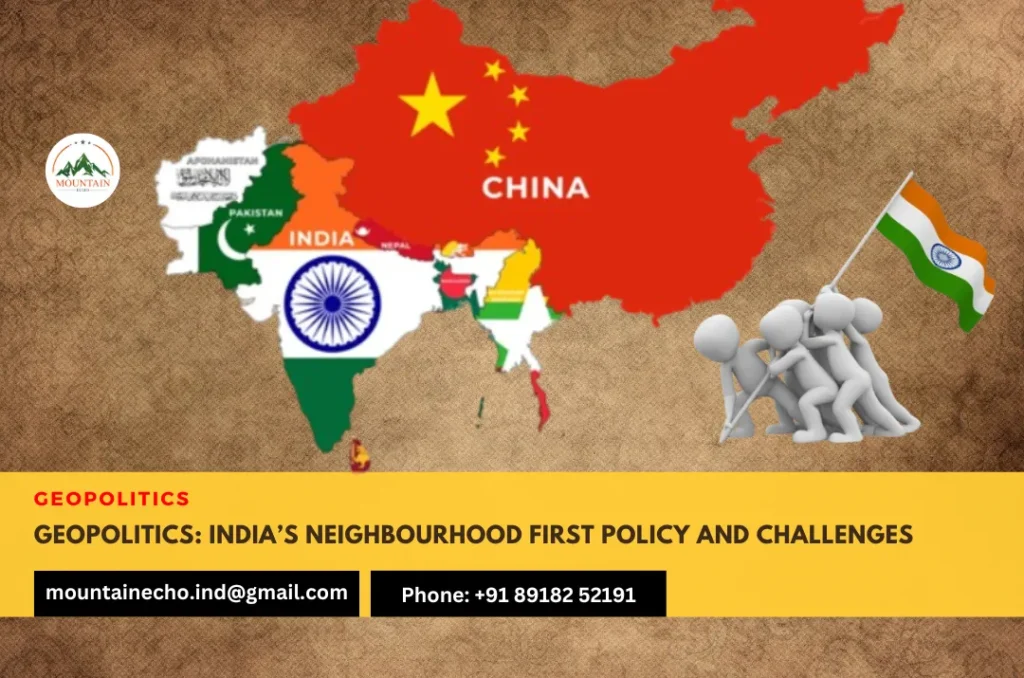Geopolitics: India’s Neighbourhood First Policy and Challenges
India’s stature in global politics has grown significantly in the last few years, more visibly under PM Modi’s Government. A new assertive India has become an important stakeholder in international geopolitics and is a strong voice on global issues.
India has historically enjoyed unrivalled primacy a resident power in South Asia – sharing long cultural, ethnic, religion, historic and civilizational ties with other countries in the Indian subcontinent. While Pakistan denies this inheritance and seeks to develop a different identity, India has continued to improve its relative position with other South Asian countries in the subcontinent over the last few decades.
India’s neighbourhood geopolitical strategies are shaped by the perception that security and peace in South Asia and the Indian Ocean as its sphere of influence. In the past, it has directly and indirectly micro-managed its neighbour country’s internal politics, changing regimes and persuading the countries to respect its security and geopolitical interests.
India’s wants that all its neighbours turn to New Delhi on any major decisions with economic and security implications. It also wants that all domestic stakeholders in those countries to do the same. This has created an impression among some sections that India is dictating its smaller neighbours’ domestic and foreign policies and that its expectations far outweighs what it offers.
With the exception of Bhutan and Afghanistan, the remaining South Asian countries – Nepal, Bangladesh, Sri Lanka, and the Maldives, have portrayed and continue to show animosity, lack of trust, and scepticism of India’s policies. Bhutan and Afghanistan retain a positive perception of India due to their border differences with China and Pakistan respectively.
In 2014, after PM Modi became the Prime Minister, he prioritized India’s relationships and foreign policy with immediate neighbours in South Asia under the ‘Neighbourhood First policy’. He made it a point to quickly visit India’s immediate neighbour countries including Bhutan Nepal, and Maldives seeking to revitalize the shared historical and cultural heritage of the South Asian region. The Neighbourhood First policy is aimed at enhancing physical, digital and people to people connectivity across the region, and augmenting trade and commerce.
However, the rise of China and its strategic rivalry with India has further complicated the problems for India. China and Pakistan use their political and diplomatic influence in these smaller countries to fuel anti-Indian protests and sentiments, often with the hopes of ideological benefits or financial and political gains.
For example, organizations like the Hefazat-e-Islam and Jamaat-e-Islami that spearhead the anti-Indian protests share strong ideological support from Pakistan and also fund them. China’s support for KP Oli in Nepal, Mohamed Muizzu in Maldives are matters of serious concerns for India.
India has somehow managed a turnaround in its relations with Sri Lanka for now. However, China’s desire to settle border disputes with Bhutan and Nepal, but not with India, is also seen as a strategic threat for India.
China, through its Belt Road Initiative (BRI) and other investments is aggressively investing in big infrastructure projects in Sri Lankan ports, Bangladesh roads and bridges, and Airports in Nepal and Maldives. Beijing has secured access to key ports along the Indian Ocean, including Gwadar in Pakistan, Hambantota in Sri Lanka, and Chittagong in Bangladesh. Today, China wields huge economic influence in South Asia and this is forcing India to work with a new sense of urgency to maintain its influence and status-quo in its neighbourhood.
To counter the Chinese influence, India has prioritized its neighbourhood policy through ’vaccine diplomacy’ during the COVID pandemic, with countries in the region (excluding Pakistan), extending lines of credit over 1 Trillion INR, covering over 162 projects in five countries in the region – Bangladesh, Maldives, Myanmar, Nepal, and Sri Lanka.
India has invested in infrastructure projects in power grids, road infrastructure, ports, energy, connectivity and has signed bilateral agreements with Nepal, Bangladesh, Srilanka, and Maldives. Although, the relations with Maldives have hit a new low with the recent diplomatic row following by Indian boycotting Maldives tourism, India’s has still shown its commitment to the project.
In a setback for China, the BRI has faced significant criticism for creating ‘debt trap’ using predatory loans that encouraged the poorer countries’ dependency. Using opaque terms and conditions, the loans accumulate unimaginable debt for the borrowing nations. China’s strategy is to grab land in South Asian countries by giving them loans on high rates for infrastructural projects. When the debtor country is unable to pay back the loans, China compels it to give ownership of the project and the land, acquire vital assets and natural resources, and extending its military presence.
China taking over the Hambantota port in Sri Lanka for a lease of 99 years, is a case in example. Pakistan, after joining the BRI with China-Pakistan Economic Corridor (CPEC) has today become the largest debtor state to China, with over one-third of external debts owed to Beijing. Many African countries receiving Chinese loans have soaring public debt. More recently, Nepal’s Pokhara international airport, built with Chinese funding, has become a financial burden for the country and left it in debt to Beijing.
Indian, as the resident power of South Asia, is more than just a trading partner in the subcontinent. It is the top sources of FDI for these countries, wields historical and social and deep political connections. While China leans heavily on project finance and investments, India has nurtured the subcontinent for a long time and various political actors in the neighbourhood have benefited from official and unofficial Indian support at different times.
However, India’s close presence in the social, political, and economic sphere of the South Asia, leaves it open to criticism, including allegations of meddling, and often fuelling anti-India sentiments and protests.
During a recent interview to a news channel, External Affairs Minister S Jaishankar pointed out that India’s Neighbourhood First Policy has remained one of the fundamental principles of the country’s diplomacy and that India’s ties with its neighbours is not transactional and is deep-seated in the region’s history, culture, and economy.
Over the past few years, India has positioned itself as supporting the growing aspirations of its neighbours. As India increasingly adopts a multi-aligned policy vis-à-vis its bilateral relationship with major powers, it is also accommodating the need of its smaller neighbours to engage more players to maximise benefits.
[The article is written by Dinesh Sharma (dineshcold@gmail.com) and first published on Sikkim Express on March 22, 2024]



